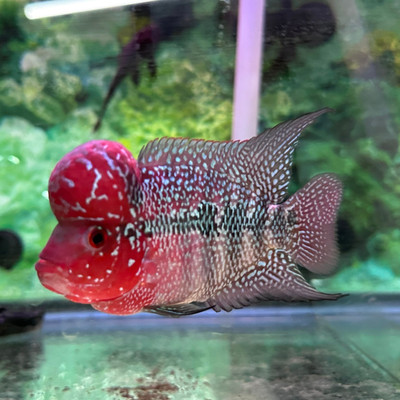Flowerhorn Cichlids: The Vibrant and Unique Gems of the Aquarium World
Posted by Max Gandara on on 21st May 2024
Flowerhorn Cichlids: The Vibrant and Unique Gems of the Aquarium World
Flowerhorn Cichlids are among the most striking and unique freshwater fish available to aquarists today. With their vibrant colors, distinct head shape, and engaging personalities, they have become highly sought after by fish enthusiasts. In this blog, we’ll delve into the fascinating world of Flowerhorn Cichlids, exploring their origins, care requirements, dietary needs, and tips for maintaining a healthy and thriving aquarium environment for these remarkable fish.
Introduction to Flowerhorn Cichlids
Flowerhorn Cichlids (hybrid cichlids) are not found in the wild but are the result of selective breeding by aquarists, primarily in Malaysia, Thailand, and Taiwan. They are known for their vivid colors, unique patterns, and the prominent nuchal hump (kok) on their heads, which gives them a distinctive and often dramatic appearance. Each Flowerhorn is unique, with variations in coloration, body shape, and head growth, making them a captivating addition to any aquarium.
Origins and Breeding
Flowerhorn Cichlids were first developed in the late 1990s through crossbreeding various Central and South American cichlid species. The aim was to create a fish with striking colors and a distinctive hump. Over time, selective breeding led to the development of different strains, each with its own unique characteristics. Some of the popular strains include Kamfa, Zhen Zhu, Golden Monkey, and Thai Silk, each admired for specific traits such as color intensity, pattern, and head shape.
Aquarium Setup
Tank Size
Due to their size and active nature, a minimum tank size of 75 gallons is recommended for a single Flowerhorn Cichlid. Larger tanks are preferred if you plan to keep multiple fish or want to create a more complex aquatic environment.
Water Parameters
- Temperature: 78-84°F (25-29°C)
- pH Level: 7.0-8.0
- Hardness: 8-20 dGH
Maintaining stable water conditions is crucial for the health of Flowerhorn Cichlids. Invest in a good filtration system and perform regular water changes to keep the water clean and well-oxygenated.
Substrate and Decor
Flowerhorns are known to dig and rearrange their environment, so a bare-bottom tank or one with fine gravel or sand substrate is ideal. Include sturdy decorations like rocks and driftwood, but avoid sharp objects that could harm the fish. Live plants are usually not recommended as Flowerhorns tend to uproot them, but hardy species like Anubias or Java Fern can sometimes survive.
Lighting
Moderate lighting is sufficient. Flowerhorns do not have specific lighting needs, but proper lighting will help highlight their vibrant colors.
Diet and Feeding
Flowerhorn Cichlids are omnivorous with a preference for a protein-rich diet. A balanced diet includes:
- Pellets: High-quality cichlid pellets formulated for Flowerhorns.
- Live or frozen foods: Bloodworms, brine shrimp, krill, and feeder fish.
- Vegetables: Occasional blanched spinach, peas, or spirulina-based foods.
Feed them once or twice a day, offering only as much food as they can consume in a few minutes to avoid overfeeding and maintain water quality.
Behavior and Tank Mates
Flowerhorn Cichlids are known for their bold and often aggressive behavior, particularly towards other fish. This territorial nature means careful consideration is needed when choosing tank mates.
Compatible Tank Mates
- Large Cichlids: Such as Oscars, Green Terrors, and other robust species.
- Catfish: Large species like Plecos and Synodontis that can coexist with Flowerhorns.
- Avoid: Small or delicate fish that can be bullied or eaten.
It’s often best to keep Flowerhorns in a species-only tank to prevent aggression and ensure their well-being.
Health and Disease
Flowerhorn Cichlids are generally hardy, but they can be susceptible to common freshwater diseases if water quality is not maintained. Watch for signs of stress and illness, such as:
- Ich: White spots on the body and fins.
- Fin rot: Fraying or discoloration of the fins.
- Internal parasites: Weight loss and reduced activity.
Preventive measures include maintaining pristine water conditions, providing a balanced diet, and observing any changes in behavior or appearance. Quarantine new fish before adding them to the main tank to avoid introducing diseases.
Breeding
Breeding Flowerhorn Cichlids can be challenging due to their aggressive nature. If you’re interested in breeding, follow these steps:
- Select a breeding pair: Choose healthy, mature individuals with desirable traits.
- Provide a separate breeding tank: At least 100 gallons with a flat surface for egg laying.
- Monitor behavior: The male can become aggressive; use a divider if necessary.
- Care for the fry: Once the eggs hatch, remove the parents to prevent them from eating the fry. Feed the fry with finely crushed flake food or baby brine shrimp.
Conclusion
Flowerhorn Cichlids are a captivating and rewarding species for experienced aquarists. Their vibrant colors, unique appearance, and engaging behavior make them a standout choice for those looking to add a bit of flair to their aquarium. By providing the right environment, diet, and care, you can enjoy the company of these fascinating fish for many years. Whether you’re a seasoned hobbyist or looking to take on a new challenge, the Flowerhorn Cichlid offers an unforgettable and enriching experience.

